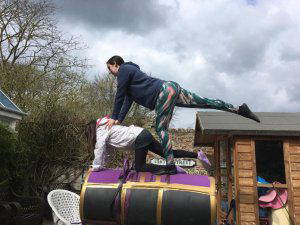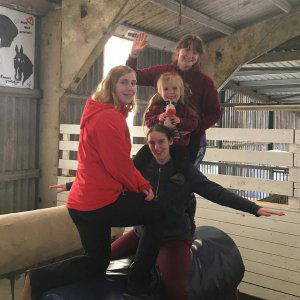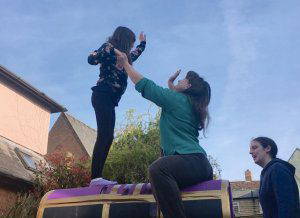This is a bit of a voyage of discovery for me, and it’s a big old topic so in the interests of not taking up too much of your time, I’m going to split it into a few chunks over the next few months. Welcome to Chunk the First – Who, What, Why, Where, When?!
When: RDA National Championships
Each year in July, the Riding for the Disabled Association runs its National Championships at Hartpury College. RDA participants can compete in a range of disciplines, and over the last few years the vaulting side has really taken off, with vaulters competing on the horse or the barrel.
This year, for the first time, I am putting together a team freestyle for a bunch of us RDA vaulters in the East Region to perform on the barrel. I’ve never put together a team freestyle before so this is testing the limits of my comfort zone!
Why: The value of barrel competition
Barrel training is a crucial part of any vaulting club but particularly for RDA Groups, which may not have access to suitably-trained horses and helpers. It also gives those who are a bit nervous, or who find mounting difficult, another way to participate safely and to gain confidence.
Beyond just training, having a pathway to competition on the barrel is vital for empowering those participants for whom competing on the horse is an impossibility. I really believe that competition drives performance and achievement, both of which have a substantial impact on a disabled person’s mental and physical wellbeing. In the interests of as many people benefitting from this as possible it’s incredibly beneficial that RDA vaulters have the opportunity to demonstrate and celebrate their skills on the barrel as well as the horse.
What: Vital statistics for the uninitiated!
What is needed for an RDA vaulting team freestyle routine?
- 1 team = six vaulters (2 can be able-bodied volunteers, but I don’t think we’ll need them!)
- Under RDA rules we are allowed one or two vaulters up at a time
- Team freestyle = 4 minutes, starting with the first touch of the barrel and ending with the final dismount

Where to start?
- Play around on the barrel and consult books, the internet and friends to come up with some inspiration.
- Make a long list of feasible moves
- Figure out which pairings of vaulters might work and what moves they could do together (by this stage you would hopefully know who your vaulters will be!)
- Test out some transitions
Testing transitions took, well, ages. It was like one of those ghastly maths problems where you have to work out how many handshakes take place at a party, except that there are fifty moves which can come before or after any other move, and each move can have one or two people in it, and there can be various different ways of transitioning into or out of it. Add in the fact that I am only one person and had nobody to experiment with, and I had to try and take into account all the different disabilities of all six of us, and you can see why it took me a very, very, VERY long time!

What next?
By this stage I had a fairly good idea of what I thought would and wouldn’t work in practice. It was tricky taking into account the different disabilities and capabilities of the team as a whole – something I can’t do, for example, another vaulter can, and vice versa. So, next I needed to go through this process:
- Plan some moves and transitions to try
- Find some willing victims guinea pig vaulters and hope that they don’t look at me like I’m totally insane when I suggest something a bit scary
- Put said willing vaulters through their paces on the ground first (where possible) and then supported on the barrel
- Breathe a big sigh of relief when the vaulters are brave and hard-working and it all works out OK!

It was tough to get to this stage, but depressingly this is the first stage that anyone will really see any evidence of when we compete! I needed to go from the endless options to one final plan. This plan needed to:
- Show off our skills as a team and as individuals
- Ensure everyone has a fairly equal role (either in terms of time or activity – so nobody should just be stuck supporting)
- Fit in the time allowed
- Tick boxes in the judge’s mind – more on this next time!
So that’s pretty much where I’m up to at the moment. Next month I’ll tell you more about how I’m trying to make the routine stand out and work as a coherent – and fun! – performance.
Search
Recent Articles
- The Good, The Bad and The Ugly of Coaching
- Does your horse need more energy, especially when competing?
- Grade 1 International Para Dressage Rider Di Green- Why Lexi Needed a Year Off
- Louise Blanch – Driving Towards New Horizons with the Continued Support of the Para Equestrian Foundation.
- Kissing Spine – Prevention or Cure?
Categories
- Advice Hub
- Athlete
- Carriage Driving
- Dentistry
- Dressage
- Endurance
- Eventing
- Farrier
- Featured
- Featured Horse Ads
- Featured Posts
- Horse Racing
- Horse's Mouth
- Horseball
- Hunting
- Le Trec
- Leisure Riders
- Mounted Games
- Nutrition
- Polo
- Polocrosse
- Reining
- Rescue & Rehabilitation
- Show Jumping
- Showing
- Tack Room
- Team Chasing
- The Pony Club
- Therapy
- Training
- Vaulting
- Veterinary




